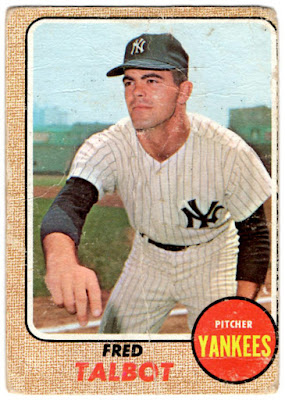 |
| 1966 Topps Calvin Koonce, #278 |
Recently a trader-friend told me he was thinking of adding a few extra cards to the package he was preparing for me. These extra cards, he warned, were old, and were beat up. Some of them were really beat up. After issuing this disclaimer, he mentioned that if I wasn't interested in the cards, he just wouldn't send them.
But I wrote back quickly and urged him to include them. The reason? I like well-worn vintage cards. They remind me of the time when baseball cards were just baseball cards—and kids actually played with them. Condition didn't matter. Value didn't matter. There were no serial-numbered cards, no relics, no inserts. You just plunked down your nickel, got your pack of cards, popped the stick of gum in your mouth, looked over the players on the front and the info on the back, and enjoyed the experience.
 |
| 1963 Topps Charley James, #83 |
Maybe a card you found in that pack featured a local player like Charley James here, who was born and raised about 10 miles from Busch Stadium. And maybe that made you think about the next game your parents (or uncle or aunt or grandparents) were going to take you to. Or maybe you thought about that game you recently heard on the radio:
Hey, look! A card of Jim Kaat. That guy pitched a complete game and got two hits of his own against Cleveland last week!*
All of that is before my time. But it's exactly what I think about when I listen to one of the many broadcasts posted on a YouTube channel named Classic Baseball on the Radio.
Playlists are organized by decade, team, announcer (wow!), regular season, and postseason. You're bound to find something you like.
 |
| 1968 Topps Fred Talbot, #577 |
These radio broadcasts, the ones of a certain vintage, just capture the magic of baseball. You won't hear long-winded descriptions of spin rates or advanced metrics. Neither will you hear joy-sapping discussions on free agency and multimillion-dollar contracts. Instead, the announcers describe the game to you—and not only the action, but what's happening between the action. Body language. Tension. The wind coming in from right-center field. The batter stepping into the box cautiously because Bob Gibson is on the mound. The third baseman creeping in on the grass, expecting a bunt. Things that painted the picture for you.
 |
| 1967 Topps Andy Etchebarren, #457 |
They're often lost on modern television broadcasts, but it's good to be reminded that the magic still exists on the radio, past and even present.
Besides, the new baseball season has arrived. The smell of fresh-cut grass is in the air. Go out and have a catch.
And the next time you're sorting through cards, turn the internet dial to Classic Baseball on the Radio, put on some of the best background noise you'll ever want to hear, and for a little while forget about those silly things like scarcity and monetary value that we connect to trading cards these days.
*Jim Kaat really did pitch a complete game while collecting two hits against Cleveland. It happened on June 27, 1966. Here's the boxscore.



































